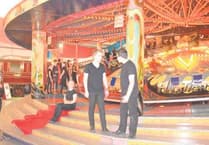FOR anyone with a love of Tavistock, the latest in a series of community books published by Halsgrove is destined to be a sure-fire winner.
Written by local historian Gerry Woodcock, The Book of Tavistock is stuffed full of fascinating photographs of the town ? so much so that initially, it is tempting just to look at the pictures to see who and what can be recognised.
But anyone not stopping to really read the book would be missing a treat. It is a real education on a town which has being growing and developing since the founding of the great Benedictine Abbey in 974.
Starting with Tavistock?s setting, between Dartmoor and the border with Cornwall, the book examines the history of all aspects of the town and its people ? from working, playing and worshipping to communicating, competing and confronting.
For hundreds of years, the town developed almost exclusively on the north side of the River Tavy.
It was not until first the cemetery, then the cottages and school were built in the 1840s on what is now Dolvin Road (Dolvin being ?presumably a corruption of Godolphin, a family with property interests in the area?) that the town began to spread towards the south.
The influence of the Bedford family on Tavistock began in the 16th century.
Following the closure of the abbey in the 16th century, monastic lands were given to John Russell, the ancestor of the dukes of Bedford, by Henry VIII.
The Bedford patronage not only shaped the appearance of the town, it influenced the lives of its inhabitants.
For instance, a survey carried out by the Duke?s estate office in 1753 revealed there were 27 professional men of the town, 63 involved in the woollen trade, 232 clothiers and 57 involved in agriculture, amongst other groups.
By the 19th century, the explosion in the mining industry was well under way and more than 460 mine workers employed on Bedford-owned land lived in the town. Mining had replaced the woollen industry as the major employer and the town expanded rapidly.
Nearby Devon Great Consols ? ?a mine of mines? according to its managing director? celebrated its 21st birthday in 1865. An account of the festivities was recorded in the Tavistock Gazette:
?For their sustenance, they had been provided with 2,000lbs of beef, 1,300lbs of bread, 1,008lbs of plum pudding, eight hogsheads of beer, four of cider and one of lemonade. Each man was given a long pipe and half an ounce of tobacco. Before the guests sat down there was a long and imposing array of huge joints. After the guests got up, there was an equally long array of bony remainders.?
Interestingly, the population of Tavistock in 2000 was roughly the same as it was in 1860, although the residential area was about six times larger.
The chapter of leisure pursuits reveal that Tavistock has long been a venue for sporting activities, ranging from wrestling and racing to cycling and cricket. Sporting enthusiasts in the town will no doubt recognise many familiar faces from teams gone by!
The development of education in the town, which started at the ancient abbey and grew throughout the centuries to encompass public and private schooling, is not neglected.
Even a list of school uniform from the 1930s is included.
What teenage girls today would make of ?three pairs of black winter-weight knickers? and the summer uniform of ?frocks, of black and white check material? , ?knickers of the same material? and ?white ankle socks? does not bear thinking about!
Amateur dramatics, royal visits, the development of travel, trade and local government are all examined within the pages of the book, accompanied by many wonderful photographs bound to prompt local people to say ?Look, remember him??.
The Book of Tavistock by Gerry Woodcock is published by Halsgrove and is available from bookshops priced £19.95.


